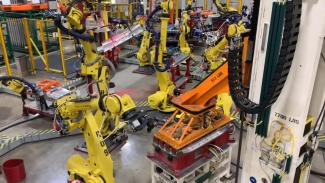An Extensive Guide to Asset Performance Management (APM)
So many industries are now heavily reliant on machinery and technology to help them deliver the best possible products and services. This simple fact makes it important for manufacturers to manage their assets and ensure they’re working in alignment with business objectives. They also must keep an eye towards the highest possible quality and efficiency. That’s where Asset Performance Management (APM) comes in. In this article, we’ll cover what APM is, how it works, and all the benefits it can bring to an organization.
What is APM?
In short, Asset Performance Management (APM) is the term used to describe the processes companies use to monitor, assess, maintain and fund the assets required to run their business. Modern APM is a combination of traditional asset management practices with new digital technologies. Manufacturers can now, through the use of Industrial Internet of Things (IIoT) and data science, increase the reliability, maintenance, execution and business performance of all their equipment. It’s a unified strategy that incorporates people, processes, and assets to create operational excellence.
How Does APM Work? APM Core Features
APM software uses data management, pattern recognition, predictive analytics, artificial intelligence, and machine learning to provide a range of core features. The Gartner Magic Quadrant for Application Performance Monitoring, a leading industry report on APM, defines these core features as:
- Automatic discovery and mapping of assets and their infrastructure components to maintain real-time awareness in dynamic environments.
- End-to-end observability of an application’s HTTP/S transactional behavior to gain insight into business outcomes and user experience.
- Mobile and desktop monitoring to understand user experience across different platforms.
- Analysis of application performance problems and down-time for faster, more reliable incident reaction and resolution.
- Integration and automation of tools and third-party sources to manage an expanding and evolving infrastructure.
- Business KPIs and user journey analysis to optimize user experience.
- Virtual desktop infrastructure (VDI) monitoring to maximize productivity of employees using VDI.
These capabilities extend to different areas of machine monitoring, here are some of the most common:
- API Monitoring to identify how application performance is impacted by third-party services.
- Application architecture to understand how patterns and techniques used to build an application influences performance and user experience.
- Service monitoring to understand how individual services impact overall application performance.
- Container monitoring to understand the context and performance of individual containers.
- End-to-end experience monitoring to gain insight into how changes to applications impact your end users.
Ready to ensure machine uptime, throughput, and maintenance?
See exactly how Plex Asset Performance Management helps you monitor variables, set thresholds, and view machine status in this on-demand demo.
Business Benefits of APM
According to Verdantix Green Quadrant for Asset Performance Management Solutions 2020, the demand for APM software has risen significantly since it was launched in the late 1990s. Global spending across all industries on APM solutions has now exceeded $2.3 billion. In this section, we will look at how the core features of APM can directly benefit businesses.
Analysis of application problems improves key machine metrics like uptime, mean time to repair (MTTR), asset longevity, on-time shipments, quality, and safety.
- Increased uptime and efficiency, in turn, improves executive metrics like revenue, margin, customer satisfaction, work-in-progress (WIP) inventory, and return on assets (ROA).
- The ecosystem for assets is extended beyond the plant floor to include a wide range of applications that leverage sophisticated OT, IT, and engineering systems.
- Modern technologies are applied to smart devices, augmented reality, and mobility to improve business processes and create new methods for asset management.
- In-depth analysis across the asset ecosystem using digital twin, digital thread and other modern information allows for greater collaboration.
- Data enhancements mean traditional practices and applications become more effective when supporting business goals.
APM With IIoT and Data Science
We mentioned before that a modern approach to asset performance analysis incorporates the use of IIoT and data science to drive deeper insights into the reliability of industrial assets, and this should be a focus for businesses looking for APM solutions. Data analytics rooted in integrated business processes look for patterns and opportunities for improvements for management teams and help answer the following questions:
- How critical is the asset?
- What is the current health of the asset?
- What might cause the asset to fail?
- How can the risks of failure be mitigated?
- What would asset failure cost?
- What action can be taken to prevent failure?
- How can this asset be optimized for maximum performance?
- How can less critical assets be managed more efficiently?
These can all be answered through the actionable information provided in real-time by advanced APM software. An example of APM with data analytics is predictive maintenance (PdM). PdM uses multiple data sources to predict the failure of equipment with a high degree of confidence, allowing for a more proactive approach to performance management. Organizations should consider reviewing their APM strategy. Increased adoption of condition monitoring and predictive maintenance solutions can further increase uptime, asset longevity, maintenance costs, and safety.
To truly drive higher asset availability with IIoT and data science you should be using the Digital Twin model that can be leveraged using APM software. The Digital Twin is a computer model of how equipment should operate and is used for accurate predictive maintenance. A significant deviation of how equipment is performing can be an indication of potential downtime and allows manufacturers to move from break-fix maintenance to condition-based strategies.
APM Platforms
Plex Asset Management Platform leverages the benefits of analytics and IIoT technology to proactively monitor machine and plant health to ensure optimal uptime, throughput, and maintenance needs. Businesses using the platform can contextualize IT/OT data in a single view to connect plant floor data with MES data to support informed decision making. Manufacturers using Plex APM can expect the following features:
Real-Time Visibility. Using real time sensor inputs, machine states, PLC events, error codes, ad part numbers, this software will generate live views of what’s going on in your manufacturing environment.
Contextual Traceability. Consolidate disparate silos of data into one system to gain a contextualized view as to why machines are not performing and what is being impacted when issues occur.
Preventative Data. Historical data storage and trend analytics allows for the support of accurate predictive maintenance and identifying potential threat of downtime.
Built-in Analytics. A variety of custom rules and analytics are available to ensure machines are running as desired and manufacturers are notified against potential machine failure.
Manufacturers using Plex APM can expect all the core features and benefits discussed in this article. If you would like more information about the platform you can find it here.




